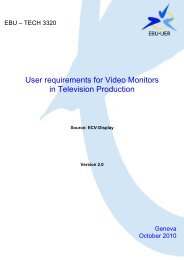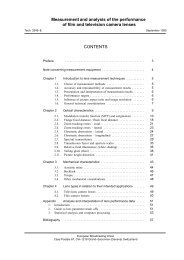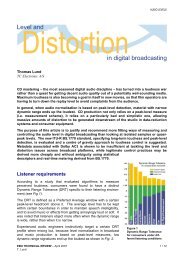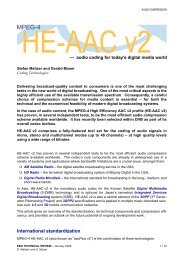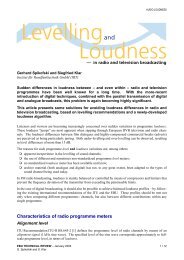Production Technology Seminar 2009 - EBU Technical
Production Technology Seminar 2009 - EBU Technical
Production Technology Seminar 2009 - EBU Technical
Create successful ePaper yourself
Turn your PDF publications into a flip-book with our unique Google optimized e-Paper software.
49<br />
the consumer could first select if they wanted to view in 720P or in 1080i. Naturally if that happened<br />
1080P50 would have reached the consumer already as the transport stream would have supported it.<br />
This matter of considering the short, medium and long term evolution to 3DTV can be given thought<br />
today before defacto or knee jerk standards enter the market place and shift consumption away from<br />
FTA channels. Effectively this kind of option is possible with 3D providing a good level of backwards and<br />
forwards compatibility and the model to evolve (to the pace felt comfortable) with 3D broadcasting.<br />
HDTV required both new displays and set top boxes. This was issue because of the considerable<br />
change from standard definition components and the attendant costs. The model put forward by<br />
TDVision will still require either a box firmware change or a new STB. However, many of the existing<br />
silicon available today is compatible with this 3D broadcast model. It‟s not such a great leap up<br />
technically in comparison to SD to HDTV. In addition, many displays that support 120Hz can work with<br />
active glasses and give a “Full 3D Ready” display at the same cost as a 2DTV. The only extra cost is<br />
active glasses. The passive polarised displays do permit a greater flexibility of glass design and are<br />
suited to when you might need to support many viewers at the same time. To apply the polarization<br />
plane to the LCD does require additional cost but at mass volumes this is not considerable. To<br />
compromise 3DTV by limiting consideration to options that only go inside a video frame limits quality,<br />
evolution potential, user experience, the option of 2D/3D single EPG channel and denies the highest<br />
quality 3DTV to the consumer.<br />
Finally a point to consider - if we are to have a new generation of “Full 3D Ready” set top boxes should<br />
this be used as a way of future proofing to cope with 1080P50? If not at this rare junction in time how can<br />
1080P broadcasting ever occur?<br />
Future technologies<br />
3.3 High Frame Rate (HFR) Television<br />
Richard Salmon, Sam Davies, Mike Amstrong, Steve Jolly, BBC R&D, UK<br />
Over 70 years ago, the TV frame/field rates were chosen, to: exceed the threshold for apparent motion,<br />
avoid visible flicker (on small screens on these days), avoid interaction with the mains frequency and<br />
provide a way of showing cinema film on TV systems. The current 50/60Hz TV was a match to standard<br />
definition pictures and smaller CRT displays. But it is not a good match for larger displays, increased<br />
picture resolution and sample-and-hold display technology (such as LCD).<br />
Because the camera has a shutter that is open for 1/50 th of the second, you get a loss of detail on<br />
moving objects. So, the static objects in the background are nice and sharp, the moving object is blurred<br />
out by the camera integration [6]. If you have a long shutter, then you have motion blur. If you have a<br />
short shutter you loose of the smoothness of the motion and introduce temporal aliasing (leading to jerky<br />
motion and spoked wheels running backwards). The short shutter will sharpen the picture, but you<br />
reduce the amount of light coming in, hence causing a loss of sensitivity.<br />
Consider a ball moving across the screen [8]. We want the ball to remain looking like a ball as it moves.<br />
If you capture it with a short shutter, you get nice sharp images (but juddery motion) – with a 50% shutter,<br />
the images are still somewhat blurred out – but with a 50% shutter at double rate you get much sharper<br />
images and much smoother motion as well, without using excessive camera shuttering.<br />
Another way of looking at the problem is, say for example you are following the action in a football match<br />
and you have upgraded your cameras and broadcast system from SD to HD, the action still happens at<br />
the same speed. If you follow this action by panning at the same speed as in SD, since you have got 3<br />
times more horizontal pixels it is 3 times more blurred as it was in SD [11]. You lost all the advantages of<br />
HD. So if you increase the resolution still further, you have to slow down the rate of panning. The<br />
problem is that the dynamic resolution of HDTV is actually no better than the dynamic resolution of<br />
SDTV [11].<br />
Historically, about 20 years ago, the BBC proposed that we should have a 80fps for HDTV, in part<br />
because we managed to get a CRT to work at 80 H<br />
© <strong>EBU</strong> <strong>2009</strong> / <strong>Production</strong> <strong>Technology</strong> seminar / January 27 - 29, <strong>2009</strong><br />
Reproduction prohibited without written permission of <strong>EBU</strong> TECHNICAL & <strong>EBU</strong> TRAINING



